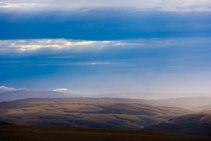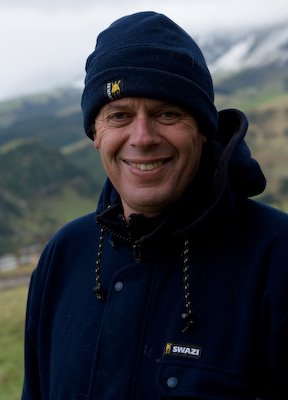
The camera will never compete with the brush and palette until such time as photography can be taken to Heaven or Hell.
Edvard Munch
Photography has always reminded me of the second child.. trying to prove itself. The fact that it wasn’t really considered an art that it was considered a craft.. has trapped almost every serious photographer.
Richard Avedon
It had been raining and it was going to rain. We sat in a comfortable trough between the voluminous skirts of one front and the impressive splendour of the next. For the time being the weather was charging its batteries, taking stock, lining itself up for the next charge across the district.
The road took us up to St. Bathans, to that unique little corner in the Maniototo, which lurks almost furtively, an armpit under the well-muscled shoulder of the Cambrian and Dunstan Mountains. Like so many places in the district, St. Bathans is in a process of self-reinvention. Ignored for years by everybody except by the local farmers, the once-bustling goldmining town is on the comeback trail, and the developers are moving in, clearing the scrub and pegging out the sections. Soon, like so many out-of-the-way places in New Zealand, St. Bathans will boom for 3 weeks a year during the holiday season, then fall silent for the remainder.
Turn right, drop down the hill, and you are at the Blue Lake, a massive water-filled hole in the landscape that is incredibly deep, a disturbance in the rhythm of the land. It is an artificial construct that bears testament to the enthusiasm of Man, to his greed for gold, the universal currency. Fertiliser runoff has discoloured the water which is now more green than blue and when the wind blows, the surface of the lake seems to tremble, as if fearful for its future. It is a place of silence and contemplation, one of those rare corners in the landscape that has its own wairua, its own sense of self. It is a place to think, to dream, to take stock, a place where past, present and future sit, one on top of the other, a place for considering questions and seeking answers.
Today it was disturbed.
As well it might be. When we pulled up at the water’s edge, and the truck motor died, the serene silence was broken by the too-loud voices of townies. Their expensive fizzboats were out of the water, squatting self-satisfied and smug on their trailers. Their conversation was loud, too loud, discordant and banal, a litany of irreverence in the deepening stillness of the place. I didn’t want to hear about the winches on their four-wheel-drives or their plans for later that day. I definitely didn’t want to know about their relationships, the clothing that that had just got at Kathmandu (at an apparently amazing price) or what they would be doing for Christmas. Surely these were things that could be discussed later. The calm in this place was worth much much more. Their insensitivity was a discordant and distinct negative in a positive space.
I noticed Alex glance across at them, a slight frown on his face. They were grating on his nerves as well. I suggested we walk around the lake edge and explore the canyons I knew were further along. Getting out our cameras, we picked our way along the lake edge, our shoes grinding softly in the soft quartz. Jack, the irrepressible pub dog, had found us, sensed an adventure and decided to come along. Maybe he found the boaties’ conversation and self-absorption boring as well. He snuffled and shuffled and bounced his way over the moraine, disappearing for a time as his nose took him along invisible lines of enquiry, than reappearing suddenly, his curiosity satisfied.
The lake was calmer around the corner, the silence beginning to get its confidence and serenity back. The voices had faded to sound-bites, snatches of the mundane flicked our way to remind us that they were still there.
We came to a small canyon carved in the quartz by the gold sluices, whose rotting pipes protruded, rusty and festering from the cliffs, a poignant reminder of an abandoned past.
We turned up one, the only sound the soft grinding of our feet in the pebbles. 20 feet in, the silence thickened and built up around us. The canyon walls closed in and stood shoulder to shoulder with us in the quietness. Alex pushed on, as young men do, and climbed to the end, looking for his own images and a view out across the lake. I checked he was OK, then turned to look behind me.
On either side, the crumbling cliffs closed in, sharing a warm, supportive companionship. Their gritty texture and soft amorphous lines seemed somehow reassuring, somehow protective. I was in a positive space.
Then I noticed a line on the ground, a runnel formed by rain runoff from the cliffs. It took my eyes on a line that led me out to the water, across to the cliffs on the other side and beyond into the sky and the remainder of the storm sliding across the gap. The contrast between the comfortable cocoon in which I nestled and the world out there was startling.
A snatch of self-important conversation muscled its way into my conversation with the cliffs.
They were still out there.
I turned my mind to what lay before me. There was a problem to be solved. It was a matter of positive and negative space.
In every image there are two things to be considered; positive and negative space. The subject (bird, plant, building, mountain) that forms your subject-of-interest occupies a space in the picture-frame, the positive space. Usually it has visual mass and a distinct presence. We can refer to it as occupying positive space.
The area round it, that is not-subject, is the negative space. And it cannot be ignored, for it and the positive space are complementary. The one impacts on the other, the one affects a reading of the other. Shadows are a case in point. They are often ignored and trip up the image, yet they can be positive spaces in their own right. As an exercise, take your camera and make a series of photographs of shadows, noting how they interact with the not-shadow areas of the image. Take the time to consider the amount of shadow you want to include, the amount of lightness and the feeling that adjusting the ratio brings to the image. A good way to do this is to defocus your camera, so you are considering indistinct shapes, and therefore are better able to see the difference between light and dark, between textured and smooth, between subtle and strong. You build an image by working with both positive and negative space, balancing one against the other according to the statement you want to make.
Back to the cliffs.
I realised that I was enjoying the relative companionship and shelter of these big brawny cliffs, my minders for a time, mates at the pub sharing friendship and a common destiny. They were a positive space for me on a number of levels. I pulled back to 24mm on my lens and let them come in close and dominate the frame. The runnel provided a linking element that took my eye back to the lake and beyond, in this case the negative space. The wide-angle pushed the distance, the negative space further away. Then it was a matter of balancing the exposure to hold highlights and shadows, to complete the statement.
By then Alex was finished. He and Jack appeared (animals are attracted to Alex; he understands them) at my shoulder, wanting to get back. They both watched me for a moment, waiting. Time to go, I said. Jack scarpered around the corner and vanished out of sight.
As we came around corner the towards the carpark, the conversation had moved on to the economics of running a 200Hp outboard motor.



3 comments:
Tony: I've seen a number of images of St Bathans (including my own), but this is a completely new and very satisfying perspective. I love the subtle colours and detail on the rocks framing the reflection in the lake and the landscape beyond.
Since learning to appreciate Japanese paintings and drawings (particularly the black and white style called "sumi-e"), I've always preferred to use the term "complementary space", even though it's not the generally accepted term. By definition, "negative space" seems to relegate it to something undesirable - association with the most commonly used meaning of the word, I suppose (although I find I don't feel this way about the complementary aspects of film). Actually, you can also think of it as a sort of reciprocity. (Light and dark. Filled space and unfilled space. Subject and not-subject. Are we getting back to balance, to mésure, here?)
Pleased to see you writing about this and love the way it seems to have been sparked by your feelings about the townies' insensitivity to the beauty of the place. Positive negativity??
Blessings to you, too, this Christmas.
P.
Hi P:
many thanks for such a lucid argument. Now you put it that way, I agree that +ve and -ve space is probably a misnomer. Your descriptors are much better. i will ponder these, along with the sumi-e thing.
A very special thank you for all your comments this tear. I really do value them.
have a wonderful Xmas.
Tony
Tony: I'm still chewing over an alternative term for "negative space". While I like the concept and use the expression, I've never felt completely satisfied with "complementary space". The "c" word seems a bit cumbersome, somehow. I wonder if there's another word that retains the concept but is a bit easier on the tongue?
And since dashing off my comment above I've realised, of course, that what you have written here wouldn't have worked nearly as well if you'd used any word other than "negative". The thing I enjoy very much when I read this post is the counterpoint between positive and negative and the way this operates on two levels: the physcial level relating to place, and the photographic level relating to the way you composed your image.
Perhaps we could describe you as the literary and photographic Byrd of St Bathans??
Post a Comment